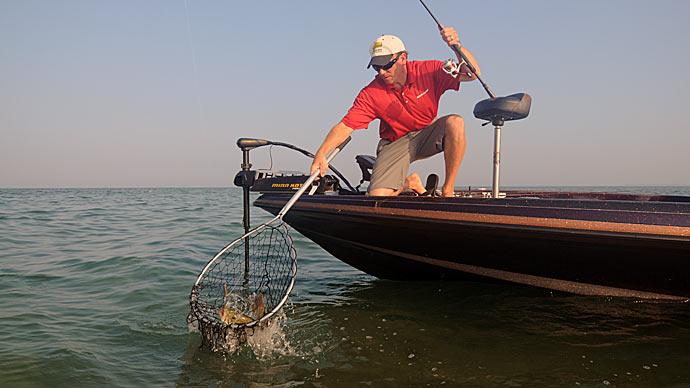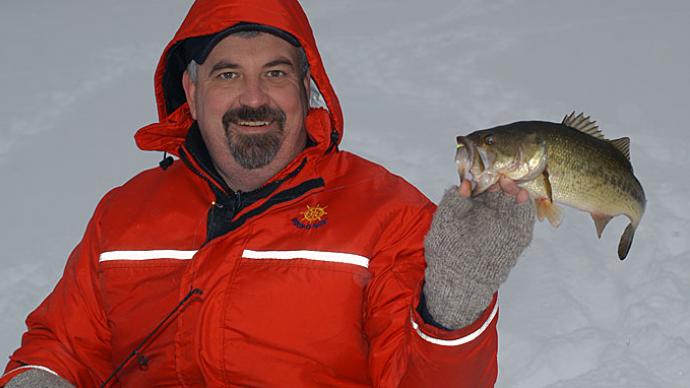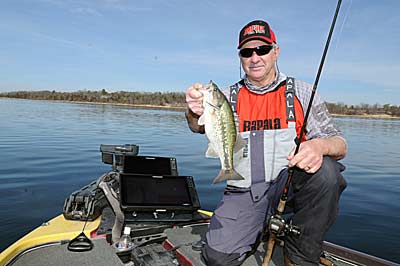
A lure initially designed for ice fishing has become a productive wintertime bass catcher on unfrozen waters.
Rapala pro staff member Tim Sainato recalls when he and his buddy Buster Loving struggled in a late winter team tournament years ago and were saved by a lure Sainato had ordered from Rapala on a whim. "The water was pretty cold, and the bass were getting real lethargic," says Sainato, who has guided (Tim Sainato Guide Service, 417-335-0037) on Table Rock, Bull Shoals, and Taneycomo lakes for more than five decades. “We were fishing jigging spoons and a lot of bass were looking at it but wouldn't hit it. So I saw one of what we call ice jigs (Jigging Rap) and tied one of them on and we started catching so many fish (and won the tournament).”
When they kept winning tournaments with the Jigging Rap, Loving wanted Sainato to keep the lure a secret, but Sainato knew it was his job to promote his sponsors, so he let the word out about the Jigging Rap. “It is crazy now, Bass Pro Shops can’t even keep them on the shelves now,” Sainato says.
The Missouri guide believes the Jigging Rap is effective because it's so alluring to sluggish bass in cold water. “Rapala designed it for lethargic fish while fishing through ice,” he says. “You don’t have to pop it real hard like a jigging spoon to give it a fluttering action. You can just let it hang there. I catch a lot of bass hardly moving it, just sitting there and shaking it slightly."
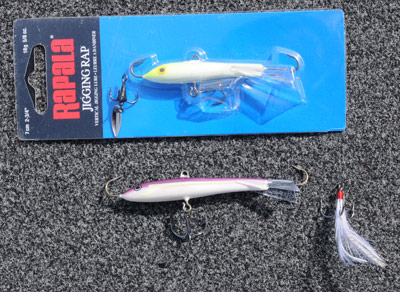
Most of the time, Sainato uses the 2 3/4-inch (W7) Jigging Rap for his winter tactic, but he occasionally opts for the 3 1/2-inch model (W9) for more active bass or if the bass are really deep. The Jigging Rap color he uses "75 percent of the time” is the glow hue. When he wants to add flash to the lure to trigger more bites, he replaces the bait's bottom hook with either a Number 6 VMC Bladed Hybrid treble or a white Number 6 VMC Dressed X-Rap treble hook.
The Jigging Rap tactic works best for Sainato in clear water on sunny days because he is usually fishing 60 to 70 feet deep. "It is dark down there (in deep water) so it seems like (the sunshine) pulls the bait up higher and makes the bass a lot more active this time of the year," he says. Sainato also prefers fishing the Jigging Rap on calm days because too much wind makes it challenging to present his lure vertically to deep bass.
The Missouri guide starts fishing the Jigging Rap in the fall when the water temperature drops into the middle to low 50s. The vertical jigging tactic produces bass throughout the winter until the water starts warming up again and bass start migrating to the bank.
Tributaries on his home waters of Table Rock and Bull Shoals are his favorite areas for trying the Jigging Rap. He concentrates on points, channel swings, and large flats adjacent to creek channels, where he searches for balls of baitfish with his Lowrance HDS Pro 16 fish finder/chartplotter. Once he finds the shad ball, he scans to the sides of the baitfish to locate any bass near the bait.
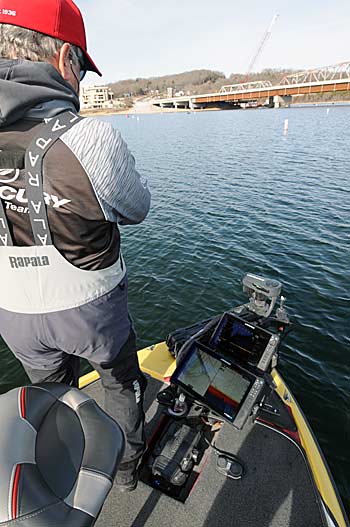
As he drops his Jigging Rap down to bass, Sainato keeps a close vigil with a combination of 2D sonar and Lowrance's Active Target forward-facing sonar to keep track of the lure's descent and how bass are reacting to his presentation. "You don’t want to move too fast,” he says. "I will hold it real still, then shake it, and occasionally, I will pop it real hard to try to get that reaction strike."
If he spots bass with his Active Target forward facing sonar (FFS) high in the water column a short distance from the boat, Sainato will pitch his Jigging Rap to the bass and let the lure pendulum back to the boat. He believes FFS is crucial in keeping track of bass and baitfish. "When you are fishing 2D sonar, you are looking at an 18- to 23-degree cone, so down deep, you have only about a 10-foot circle to look at, but with forward-facing sonar, you might be able to see a school of shad 40 feet away, so you can go over there," he says. "It is your eyes under water."
The former Bassmaster Top 150 competitor presents his Jigging Rap on a 6-foot, 10-inch or 7-foot medium action casting rod and baitcast reel spooled with 12-pound fluorocarbon line. Sainato claims the sensitivity of fluorocarbon makes it a must for fishing deep because he notes you can barely feel a bite with monofilament when you have 50 to 60 feet of line out. The Jigging Rap will cause line twist if fished straight on the main line, so Sainato prevents this problem by tying a Bass Pro Shops Number 10 barrel swivel to his main line and tying a 15- to 16-inch fluorocarbon leader to the swivel and Jigging Rap.
Sometimes if he cannot see any bass cruising near the shad balls, Sainato will drop the Jigging Rap to the lake's floor to see if any bass are hugging the bottom. "Then I will kind of lift it off the bottom and keep watching my depth finder,” he says. “If I see bass, I fish for them; I don't care if they are on the bottom or up suspended."
The average bottom depth he finds bass is about 60 to 75 feet, although he has caught some suspended bass at 52 feet with a bottom depth of 104 feet. The deepest bass he has ever caught on the bottom was 82 feet.
The Jigging Rap produces both numbers of bass and quality bass for Sainato. The Missouri guide claims he mainly catches numbers of spotted bass and occasional smallmouth bass on the lure, but he has also caught 6- and 7-pound largemouth and big white bass with the Jigging Rap.
“You are liable to catch anything on it,” Sainato says.


